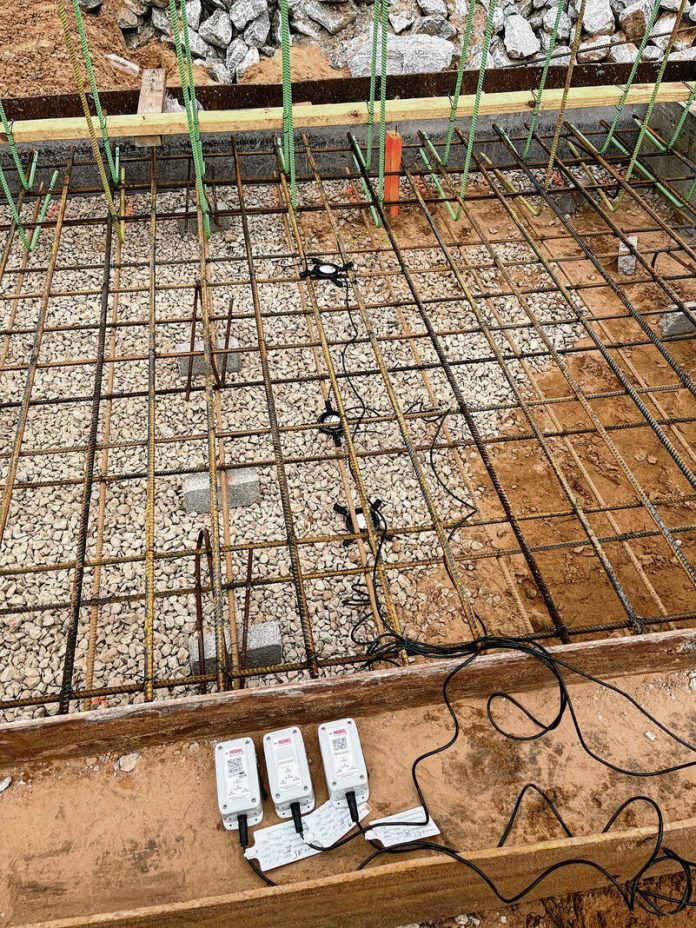Sensors that could change a century-old system of measuring road strength are being installed at the Interstate 69 and Interstate 465 interchange.
The sensors made by WaveLogix could help reduce global carbon emissions by about a billion tons a year through a decrease in excess cement production if they’re used widely enough, said Henry Silva, product development engineer for the company. They can also speed up projects, as engineers and construction workers will be able to determine the strength of concrete in real-time, saving taxpayer dollars, he said.
The tech startup company was formed by Silva and Purdue College of Engineering Associate Dean of Faculty Luna Lu when Silva was an undergraduate student.
Researchers at Purdue developed the WaveLogix REBEL Concrete Strength Sensing System over the course of several years, starting in 2016 when students began working on designing the sensors. Purdue engineering student and WaveLogix co-founder Zhihao Kong got the technology to work in a lab setting, but needed an interface with the sensors so data could be uploaded from them automatically, Silva said.
With Lu serving as the co-founder and CEO and Silva serving as the product development engineer, WaveLogix began working on a product that transportation departments across the country could use.
“The average person may notice construction doesn’t take as long,” Silva said. “But in the industry, when technology like this comes out, it will completely replace the old testing method and open a new era of construction by being able to make more data-driven results and look at infrastructure problems way differently than before.”
The predominantly used method of concrete strength measurement involves taking cylindrical samples of concrete and putting pressure on them using a hydraulic press to determine if they can withstand the weight of vehicles, Silva said.
When taken from the road, the samples often did not have the same strength as the rest of the road, leading project engineers to overcompensate by adding too much cement to the mixture, which also decreases the longevity of the road. The samples also required construction workers to wait for the samples to be tested, whereas the WaveLogix sensors will allow real-time updates of road strength uploaded through cloud services after they’re buried in the road, Silva said.
“Our system is made up of three components, the first is the sensor itself, a disc-looking thing with a cable coming out of it, which attaches to a data logger. It plugs in and it’s taking measurements from the sensor, which sends it to the cloud. Dashboard users can remotely observe the road’s strength over time,” he said. “It’s really significant because it’s going to be a breakthrough technology in this industry, replacing an over 100-year-old testing method.”
The Indiana Department of Transportation began working with Purdue University to conduct further research on the sensors in 2017, INDOT spokesperson Natalie Garrett said in an email.
“The agency recognized the technology as an opportunity to have the ability to potentially measure the ‘real time’ strength of concrete pavements, specifically helping gauge when to open a newly-paved or patched section of road to traffic,” she said. “The information provided by the sensors would ideally help engineers and construction personnel avoid putting traffic on new concrete before it has sufficient strength to accommodate the load.”
The first successful sensor test was on Interstate 65 near Lafayette in 2020, and interest in the product has grown exponentially since then.
“Originally, the project was something INDOT funded, but since then 12 states have joined, which includes a financial contribution to the technology that goes into the WaveLogix lab. We fulfill our obligation by deploying our technology in their state,” Silva said.
Along with Indiana, members of WaveLogix are piloting products in Missouri, Tennessee, Kentucky, Texas, Kansas, Colorado, North Dakota and California, among other states, Silva said.
Now, the sensors will help INDOT officials cap off one of the most ambitious road projects in state history. The first sensors for the I-465/I-69 interchange were placed last week. As the $2 billion I-69 extension project from Martinsville to Marion County wraps up next year, INDOT leaders will be able to determine the strength of the interchange in real-time as they prepare to open it next year, Garrett said in an email.
“The potential impact these sensors could have is huge,” she said. “By acquiring data on-site, there is significant time savings, as well as less labor and logistics involved to complete concrete strength testing. Additionally, the data collected can help prevent premature concrete failure due to opening a section of concrete pavement too soon, ideally avoiding the need for patching in the near future.”







